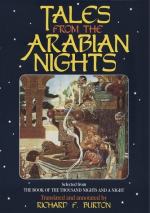[FN#56] Arab. “Akyal,” lit. whose word (Kaul) is obeyed, a title of the Himyarite Kings, of whom Al-Bergendi relates that one of them left an inscription at Samarcand, which many centuries ago no man could read. This evidently alludes to the dynasty which preceded the “Tobba” and to No. xxiv. Shamar Yar’ash (Shamar the Palsied). Some make him son of Malik surnamed Nashir al-Ni’am (Scatterer of Blessings) others of Afrikus (No. xviii.), who, according to Al-Jannabi, Ahmad bin Yusuf and Ibn Ibdun (Pocock, Spec. Hist. Arab.) founded the Berber (Barber) race, the remnants of the Causanites expelled by the “robber, Joshua son of Nun,” and became the eponymus of “Africa.” This word which, under the Romans, denoted a small province on the Northern Sea-board, is, I would suggest, A’far-Kahi (Afar-land), the Afar being now the Dankali race, the country of Osiris whom my learned friend, the late Mariette Pasha, derived from the Egyptian “Punt” identified by him with the Somali country. This would make “Africa,” as it ought to be, an Egyptian (Coptic) term.
[FN#57] Herodotus (i. 80) notes this concerning the camel. Elephants are not allowed to walk the streets in Anglo-Indian cities, where they have caused many accidents.
[FN#58] Arab. Wahk or Wahak, suggesting the Roman retiarius. But the lasso pure and simple, the favourite weapon of shepherd and herdsmen was well-known to the old Egyptians and in ancient India. It forms one of the T-letters in the hieroglyphs.
[FN#59] Compare with this and other Arab battle-pieces the Pandit’s description in the Katha Sarit Sagara, e.g. “Then a confused battle arose with dint of arrow, javelin, lance, mace and axe, costing the lives of countless soldiers (N.B.— Millions are nothing to him); rivers of blood flowed with the bodies of elephants and horses for alligators, with the pearls from the heads of elephants for sands and with the heads of heroes for stones. That feast of battle delighted the flesh-loving demons who, drunk with blood instead of wine, were dancing with the palpitating trunks,” etc.. etc. Fasc. xii. 526.
[FN#60] The giraffe is here mal-place: it is, I repeat, one of the most timid of the antelope tribe. Nothing can be more graceful than this huge game as it stands under a tree extending its long and slender neck to the foliage above it; but when in flight all the limbs seem loose and the head is carried almost on a level with the back.
[FN#61] The fire-arms may have been inserted by the copier; the cross-bow (Arcubalista) is of unknown antiquity. I have remarked in my book of the Sword (p. 19) that the bow is the first crucial evidence of the distinction between the human weapon and the bestial arm, and like the hymen or membrane of virginity proves a difference of degree if not of kind between man and the so-called lower animals. I note from Yule’s Marco Polo (ii., 143) " that the cross-bow was re-introduced into European warfare during the twelfth century”; but the arbalesta was well known to the bon roi Charlemagne (Regnier Sat. X).




